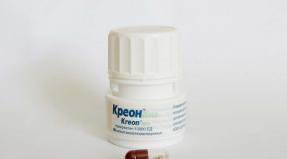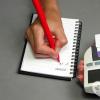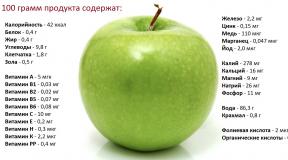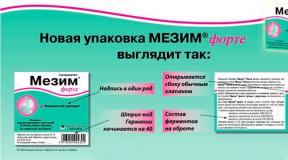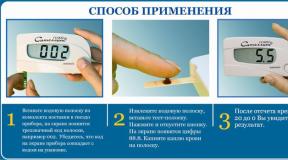Preparing for a blood sugar test
blood test for sugar urinalysis for sugar
Preparing to donate blood Reasons for abnormal tests
Glucose (sugar) is the main energy supplier, without it the normal functioning of organs and systems is impossible. As a result of an increase or decrease in the amount of glucose in the body, pathological processes develop.
Therefore, it is important to control blood sugar levels, especially for people diagnosed with diabetes. Glucose control is carried out using simple procedures: blood and urine tests for sugar.
Blood tests for sugar content are divided into basic and clarifying. The main ones include:
- Express method - the measurement is carried out using a portable device - a glucometer. The advantage of the express method is the possibility of analysis by the patient at home. The disadvantage is that if the rules for using the glucometer are violated (incorrect measurement technique, expired test strips), large errors in the measurement results are possible.
- Laboratory method - the measurement is carried out in the laboratory of the clinic.
Clarifying analyses:
- On glycated hemoglobin - allows you to evaluate the average blood glucose for three months. With the help of this analysis, it is possible to assess the quality of diabetes therapy and make adjustments to the treatment regimen.
- Glucose tolerance test - is prescribed to confirm the diagnosis of "diabetes mellitus" or to identify a pre-diabetic condition. The method of conducting is that first they measure fasting blood sugar, then the patient drinks a glucose solution. After that, the blood sugar content is measured every half an hour, making a graph.
Preparing to donate blood
Their reliability depends on the correctness of preparation for the delivery of tests, therefore it is necessary:
- For 8-10 hours before donating blood, do not eat anything (the analysis is usually carried out in the morning on an empty stomach), drink only water.
- Do not drink alcoholic beverages the day before the examination.
- Before the examination, if possible, exclude medication.
- Do not brush your teeth or chew gum before donating blood.
- Try to avoid stressful situations.
For research, blood is taken from a finger, sometimes from a vein; when conducting an analysis for glycated hemoglobin, blood sampling is carried out only from a vein (it is not necessary to do an analysis on an empty stomach here).
Blood test results
1) The physiological content of glucose in the study of blood taken from a finger on an empty stomach is 3.3-5.5 mmol / l, with a decrease in these indicators, hypoglycemia occurs.
With a result of 5.5-6.1 mmol / l, the patient is prescribed a clarifying glucose tolerance test; if, during an examination on an empty stomach, the numbers rise above 6.1 mmol / l, the diagnosis is "diabetes mellitus".
2) When blood is taken from a vein, sugar indicators indicating the absence of pathology are slightly higher: from 3.7 to 6.1 mmol / l. If the patient is not examined on an empty stomach, the indicators will be in the range of 4.0-7.8 mmol / l.
In children the results of a blood test taken from a finger vary depending on age: in babies up to a year - 2.8-4.4 mmol / l, from one to five years - from 3.3 to 5.0 mmol / l, after five years, blood glucose levels are the same as in adults.
In pregnant women due to frequent disruptions in the work of the hormonal, endocrine and other systems, the blood sugar content often differs from normal levels. The norm in pregnant women is the level of 3.8-5.8 mmol / l, with indicators above 6.1 mmol / l, a second examination is carried out.
Sometimes pregnant women are diagnosed with gestational diabetes mellitus - a hyperglycemic condition that disappears on its own after childbirth. This phenomenon may indicate a woman's propensity to develop type 2 diabetes.
Urinalysis for sugar
No less informative is the analysis of urine for sugar. To detect sugar in it, it is enough to pass a general (clinical) analysis. For research collect morning urine. Normally, sugar should be absent, sometimes its content is allowed up to 0.8 mol / l. If sugar is found in large quantities, additional studies are prescribed, including a daily urine test for sugar (mandatory for pregnant women).
An analysis of urine collected during the day gives an idea of how much glucose is excreted in the urine from the body in 24 hours. The analysis is given if diabetes is suspected. The method of conducting this study is that the patient collects all urine in one container during the day (usually from the morning of one day to the morning of another).
The collected urine is stored in the refrigerator, after the collection is completed, the material is shaken and poured 100-150 ml into a small container. This amount is sent to the laboratory for analysis.
Before passing urine for sugar, you should not take medicines (especially diuretics), eat sweet foods that can color urine (beets, carrots, and others). It is also necessary to avoid stress and alcohol intake.
Reasons for deviation of analyzes from the norm
Most often, an increase in glucose in the blood and urine is a sign of the development of diabetes. But there are conditions in which sugar levels also increase, these include:
- Stress, physical overload; epilepsy.
- Deviations in the work of the adrenal glands.
- Taking hormones or diuretics.
- Eating before testing.
Decrease in the amount of glucose in the body is observed when:
- Deviations in the work of the liver caused by hereditary or acquired diseases.
- Prolonged fasting.
- Taking alcohol.
- Digestive disorders.
- Vascular diseases.
- Incorrect dosage of insulin in the treatment of diabetes mellitus.
- Neurosis, mental illness.
- Tumors of the pancreas.
Daily monitoring of blood sugar is necessary primarily for patients with diabetes mellitus. Indications for a mandatory annual blood and urine test for the amount of glucose:
- Having close relatives with diabetes.
- Obesity.
After 40 years, even people who are not predisposed to diabetes should undergo a blood sugar test every three years. The frequency of testing by pregnant women is determined by the doctor.
diabet-doctor.ru
There are several types of blood tests for sugar (glucose) levels. They are taken on an empty stomach, during the day and under a sugar load.
What should be the preparation for donating blood for sugar? Many people who are given this test for the first time worry about getting it right. They are, of course, right, because the conditions under which it is taken will affect its results.
Special preparation for it is not required, but between the time of the evening meal and the time of blood sampling, at least 8 hours should pass, and even better - 12. At this time, you can not only eat, but also drink sweet drinks (not to mention alcohol ). Only plain water is allowed. It is also not recommended to smoke before taking the test.
If the doctor has prescribed a blood sugar test for you, which is not taken on an empty stomach, but during the day, you should know that in this case, after eating, it should take from 1 hour to 1.5 hours. On the result, the mark “after eating” is made.
Before donating blood for sugar, you should also not take any medications. If you have an exacerbation of diseases or a cold at this time, it is not recommended to take an analysis. A day or two before delivery, it is advisable to avoid fried and fatty foods, as well as alcohol. If you had a feast the day before, then the results of the study may have an error. Ask your doctor to schedule another examination time.

It is also not recommended to strain yourself both physically and emotionally before surrendering. If you quickly climbed the stairs, do not rush to immediately enter the laboratory. Sit in the corridor for 10-15 minutes, relax and only in a calm state go to the test.
Blood can not be donated immediately after massage, physiotherapy, ultrasound, X-ray, reflexology. If you are taking any medications, tell your doctor. The analysis is given either before the start of taking the medication, or two weeks after the completion of the course of taking them.
When an analysis for sugar under load is prescribed, the preparation in it is the same as when it is taken on an empty stomach. The first blood sample is taken on an empty stomach, then the patient drinks a saturated sugar solution, and repeat samples are taken every half an hour for a two-hour period.
Reviews and comments
www.saharniy-diabet.com
What does blood glucose mean
According to statistics, 6% of the world's population suffer from type 2 diabetes, and in Russia this figure has exceeded 3 million. And this is just official data. In fact, this figure is much higher. According to doctors - endocrinologists, this figure is 3-4 times higher, because many people have this disease, but for various reasons it has not yet been identified.
Why is this happening? Diabetes mellitus is asymptomatic for a long time, without showing itself. In this case, all body systems are affected, as a result of which the quality and duration of life are significantly reduced. And only an examination can reveal this disease. And the earlier this disease is detected, the more likely it is to slow down the course of the disease.
Glucose is an essential component of human metabolism. This source of energy is absolutely necessary for all cells of the body. Its main supplier is bread, cereals, potatoes, pasta, fruits and vegetables, sugar and sweets.
Carbohydrates are broken down in the gastrointestinal tract to form glucose. In the intestine, being absorbed into the blood, it reaches every cell in the body. But to get inside the cell, you need insulin, which is produced in the pancreas.
With each entry of glucose into the bloodstream, and this happens after each meal, insulin is immediately released into the bloodstream. Therefore, after a meal, a person always has an increased sugar content, but for a short time. After a while, the level drops back to a certain level. Below this level, sugar should not “fall”, otherwise the body will not have enough energy for its functioning.
But not all glucose goes to the functioning of the body, part of it goes to the depot, which is located in the muscles and liver. As soon as the body needs additional energy, and there is no new batch (the person did not have time to eat), glucose comes from the depot back into the blood and its level in the blood returns to normal.
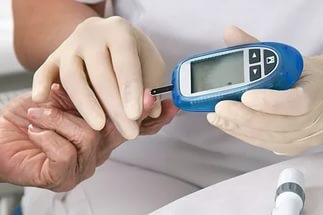
Who is assigned the analysis
Determining the sugar level is necessary in order to know how glucose is absorbed and used by the body. Changes in the results indicate violations of carbohydrate metabolism and the presence of diabetes mellitus. Therefore, all adults, in the interests of their health, should be examined for sugar once a year.
- people with blood relatives with diabetes;
- obese or overweight;
- people who have had thyrotoxicosis (a disease associated with increased production of thyroid hormones);
- women who had gestational diabetes mellitus during pregnancy or had miscarriages of unknown etiology;
- patients receiving glucocorticoid therapy.
Determining the level of glucose in the blood is included in the biochemical analysis, so there may be other situations for taking the analysis. Pregnant women, patients before surgery, as well as with certain liver diseases are subject to mandatory examination.
Preparation for the delivery of the analysis
To find out the level of sugar in the blood, it is necessary to donate blood in the laboratory from a finger or a vein. But at the same time, it is very important to properly prepare for the delivery of the analysis.
For the reliability of the result, blood must be taken 8 hours after eating, that is, on an empty stomach, but not more than 14 hours. It is usually done like this: in the evening you can make a light dinner, and immediately before the test, you can not eat or drink anything.
Prolonged fasting can also show an unreliable result: if a person has not eaten for a long time, then glucose begins to come from the depot, and the analysis may show a false result, that is, more than it actually is.
You ask, what if such an analysis should be taken by a child or a pregnant woman. Unfortunately, the rules for preparing for the test for children and pregnant women are the same, that is, blood should be taken on an empty stomach. If a woman can still endure 8 hours without problems, then with a child, of course, it is more difficult, especially if it is a small child. But the child will also have to be patient and in no case should he be fed or watered. Juices, tea are also food.
Usually, patients with diabetes mellitus and children are allowed to take blood for sugar without waiting in line.
Normal blood sugar
So, the analysis was passed, the laboratory assistants checked the blood and, of course, we are also interested in the result of the analysis. In different laboratories, the range of normal fasting glucose levels may vary, so you need to focus on the norm numbers indicated on the forms.
In capillary blood taken from a finger, the normal blood sugar level is from 3.3 to 5.5 mmol / l.
In venous blood or capillary plasma, the normal value is approximately 12% higher and ranges from 3.6 to 6.1 mmol / l.
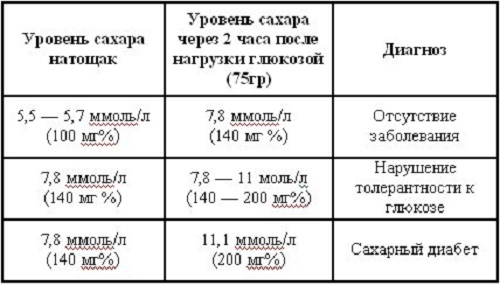
Deviations from the norm
Excess The level of glucose in the analysis indicators indicates a violation of carbohydrate metabolism, which often happens with diabetes mellitus. If this happens for the first time, then the doctor must prescribe an additional examination for you to clarify the diagnosis: determination of glycated hemoglobin and a glucose tolerance test.
downgrade glucose levels can sometimes be normal. This happens when the sugar level is below 3.3 mmol / l and the general condition remains satisfactory. Usually this is attributed to an individual feature. But if the indicator is even lower than this figure, then an additional examination is required.
Any deviation from the norm should alert you. The increase may be the result of malnutrition, especially in patients with diabetes. But if you do not have this disease, you still need to pay attention to what we eat. Any carbonated drinks, cookies and pastries, sweet and rich food can eventually lead to elevated blood sugar levels, which sometimes already leads to irreversible changes in the pancreas.
Dear readers, I hope that now you are savvy in terms of the correct test for sugar. I wish you that this analysis is always normal for you. If the information was useful to you, share it with your friends on social networks. networks. And also subscribe to updates and you will be the first to learn many more interesting things, including how you can check your sugar at home
See you soon on my blog pages! I was with you Taisiya Filippova.
taiafilippova.ru
Blood sugar
Glucose is considered an important substance that supplies energy to the body. However, blood sugar indicators must have a certain norm so as not to cause the development of a serious disease due to a decrease or increase in glucose.
It is necessary to take tests for sugar in order to have complete information about the state of your health. If any pathology is detected, a full examination is carried out to find out the cause of the violation of the indicators, and the necessary treatment is prescribed.
The concentration of glucose in a healthy person is usually at the same level, except for some moments when hormonal changes occur. Jumps in indicators can be observed in adolescents during growing up, the same applies to a child, in women during the menstrual cycle, menopause or pregnancy. At other times, a slight fluctuation may be allowed, which usually depends on whether the tests were taken on an empty stomach or after a meal.
How to donate blood for sugar
- A blood test for sugar can be taken in the laboratory or done at home with a glucometer. In order for the results to be accurate, it is important to follow all the requirements that the doctor has indicated.
- Some preparation is required before taking the test. Before visiting the clinic, you can not take coffee and alcohol-containing drinks. It is correct to take a blood test for sugar on an empty stomach. The last meal should be no earlier than 12 hours.
- Also, before taking tests, you should not use toothpaste to brush your teeth, as it usually contains an increased amount of sugar. Similarly, you need to give up chewing gum for a while. Before donating blood for analysis, you must thoroughly wash your hands and fingers with soap so that the glucometer readings are not distorted.
- All studies should be carried out on the basis of a standard diet. Before taking the test, you should not starve or overeat. Also, you can not take tests if the patient suffers from acute diseases. During pregnancy, doctors also take into account the peculiarities of the body.
Methods for taking blood to determine the level of glucose
Today, there are two ways to determine the level of glucose in a patient's blood. The first method is to take blood on an empty stomach in the laboratory at polyclinics.
The second option is to test at home for glucose using a special device called a glucometer. To do this, a finger is pierced and a drop of blood is applied to a special test strip that is inserted into the device. The test results can be seen in a few seconds on the screen.
Additionally, an analysis is taken from venous blood. However, in this case, the indicators are overestimated due to a different density, which must be taken into account. Before passing the analysis in any way, you can not eat. Any food, even in small quantities, raises blood sugar levels, which is reflected in the indicators.
The meter is considered to be a fairly accurate instrument, but you must handle it correctly, monitor the expiration date of the test strips and do not use them if the packaging is broken. The device allows you to control the level of changes in blood sugar at home. To obtain more accurate data, it is better to take tests in a medical institution under the supervision of doctors.
Blood sugar levels
When taking an analysis on an empty stomach in an adult, the indicators are considered normal if they are 3.88-6.38 mmol / l, this is exactly the norm of sugar on an empty stomach. In a newborn child, the norm is 2.78-4.44 mmol / l, while in infants, blood is taken in the usual way, without starvation. Children over 10 years of age have a fasting blood sugar rate in the range of 3.33-5.55 mmol / l.
It is important to bear in mind that different laboratories may give inconsistent results, but a difference of a few tenths is not considered a violation. Therefore, in order to get really accurate results, it is worth going through an analysis in several clinics. You can also take a sugar test with an additional load to get a correct picture of the presence or absence of the disease.
Causes of an increase in blood sugar
- A high level of glucose in the blood can most often report the development of diabetes. However, this is not the main reason, a violation of indicators can cause another disease.
- If no pathologies have been identified, non-compliance with the rules before testing can increase sugar. As you know, on the eve you can not eat, overwork physically and emotionally.
- Also, overestimated indicators may indicate the presence of a violation of the functionality of the endocrine system, epilepsy, diseases of the pancreas, food and toxic poisoning of the body.
- If a doctor has diagnosed diabetes or prediabetes, you need to take care of your diet, go on a special therapeutic diet, do fitness, or just start moving more often, lose weight and learn how to control blood sugar levels. You should give up flour, fatty. You need to eat at least six times a day in small portions. Calorie intake per day should not exceed 1800 kcal.
Reasons for low blood sugar
Low blood sugar can indicate malnutrition, regular consumption of alcohol-containing drinks, soda, starchy foods and sugary foods. Hypoglycemia is caused by diseases of the digestive system, impaired functionality of the liver and blood vessels, nervous disorders, and overweight.
After the results are received, you need to see a doctor and find out the reason for the low rates. The doctor will conduct an additional examination and prescribe the necessary treatment.
diabethelp.org
How to take a blood sugar test
In order for the results to be correct and correct, it is necessary to follow a few fairly simple rules for taking a blood test for sugar.
He must definitely give up on an empty stomach. In addition, a temporary break after the last meal is also important - it should be at least 12 hours. During all this time, it is only allowed to drink, and only water.
Remember, in order not to distort the results of the analysis, drink only clean drinking water. It is better not to use mineral water, despite the fact that it is salty. Naturally, you need to give up juices and soda.
Before taking a blood test for sugar, doctors do not even recommend brushing your teeth, because the paste contains various dyes and additives that penetrate the body and can affect the results of the study. The same goes for chewing gum.
The analysis itself is taken from the finger. The procedure is the same as for taking a general analysis. However, sometimes such a study is prescribed in combination, and then doctors take blood from a vein.
There are situations when a person has immunity to glucose. In this case, on an empty stomach, his glucose level is normal, but after eating it rises sharply. In such a situation, it is recommended to take a glucose tolerance test twice in the morning. First on an empty stomach, then something to eat and then donate blood again.
www.kakprosto.ru
The role of glucose
Glucose performs a very important function in the body - energy, and is a kind of "fuel" for cells. To fully provide organs and systems with glucose, it is enough that its level in the blood is in the range of 3.3-5.5 mmol / l. And if this indicator exceeds these figures, or falls below the norm, a person develops diseases of the endocrine system.
A blood test for sugar is not a complicated procedure, and at the same time quite informative. In addition, the analysis is inexpensive and fast.
Types of analysis
There are 2 main and 2 clarifying types of blood glucose test:
- laboratory method;
- express method;
- glycated hemoglobin test,
- sugar load test.
The most reliable is considered to be a laboratory method, which is carried out in the laboratories of medical institutions. You can use the express method using a glucometer device on your own, at home, without having any special skills. However, if the device malfunctions, it is used incorrectly, or the storage conditions of the test strips are not observed, the result error can reach twenty percent.
When should you do a blood sugar test?
There are a number of pathological conditions, in order to find out the cause of which, it is necessary to donate blood for glucose:
- sudden weight loss;
- increased fatigue;
- feeling of persistent dryness in the oral cavity;
- feeling of constant thirst;
- increase in urine output.
People with overweight, high blood pressure, and relatives with impaired carbohydrate metabolism are at risk. They are advised to control sugar constantly.
As an independent laboratory study, this analysis is prescribed:
- with a comprehensive examination;
- to assess the patient's condition with an already diagnosed pathology of carbohydrate metabolism;
- to follow the dynamics during treatment;
- to confirm the diagnosis (pancreatitis, obesity, endocrine pathologies).
Preparation for the delivery of the analysis
In order to get the most reliable results, before donating blood for sugar, the following recommendations must be observed:
- 8 hours before the analysis, do not eat anything, and use only water as a drink;
- 24 hours before the analysis do not drink alcohol;
- in the morning before taking the test, it is forbidden to chew gum and brush your teeth;
- if you are taking any medications, you should refuse to take them on the eve of the study, or, if this is not possible, be sure to notify the doctor.
Blood for analysis is taken from a finger, usually in the morning and always on an empty stomach.
Deciphering the analysis
Normal indicators of a blood test for sugar are numbers from 3.5 to 5.5 mmol / l. The state in which the glucose level rises to 6.0 mmol / l is called pre-diabetic. Often this is due to non-compliance with the recommendations in preparation for the analysis. The result of 6.1 mmol/l and above is the basis for diagnosing diabetes mellitus.
Causes of deviations from the norm
Diabetes is the main, but not the only, cause of high blood sugar. This indicator may be higher than normal in the following conditions:
- emotional and physical stress;
- epilepsy;
- pathology of the pituitary gland, adrenal glands, thyroid gland;
- eating before analysis;
- the action of toxic substances (for example, carbon monoxide);
- taking certain medications (nicotinic acid, thyroxine, diuretics, corticosteroids, estrogens, indomethacin).
Low blood sugar occurs when:
- alcohol poisoning;
- liver pathologies;
- fasting for a long time;
- diseases of the digestive system (enteritis, pancreatitis, etc.);
- obesity
- violation of metabolic processes;
- vascular diseases;
- tumor formations in the pancreas;
- poisoning with toxic substances (for example, arsenic);
- diseases of the nervous system;
- insulin overdose in diabetic patients;
- sarcoidosis.
Clarifying Research
To exclude or confirm diabetes, additional studies are carried out.
Glucose tolerance test
The patient takes blood 4 times within 2 hours. The first time - in the morning, on an empty stomach. Then he drinks glucose (75 grams), after which an hour later, 1.5 hours and 2 hours later, the analysis is repeated. At the same time, there is a change in the blood sugar level: at first, after consuming glucose, it rises, then it decreases. The result is evaluated throughout the test. The results of the test 2 hours after taking glucose:
- sugar less than 7.8 mmol / l - the norm;
- sugar from 7.8 mmol / l to 11.1 mmol / l - the state of prediabetes;
- sugar more than 11.1 mmol / l - diabetes.
Glycated hemoglobin
This biochemical test shows the average blood sugar content over a certain period (up to 3 months). With its help, the percentage of hemoglobin that "forever" binds to glucose molecules is determined (Maillard reaction). If the glucose level is elevated (in diabetes mellitus), this reaction is much faster, which leads to an increase in the level of glycated hemoglobin in the blood.
Using this analysis, the effectiveness of the treatment of diabetes mellitus, which was carried out by the patient for the last 3 months, is evaluated. The normal level of glycated hemoglobin is 4-9%. If the indicators exceed the norm, there is a high probability of complications: retinopathy, nephropathy, etc. An indicator of more than 8% indicates the need to adjust therapy due to its ineffectiveness. For analysis, blood is taken from a finger at any time, regardless of when the person last ate.
www.infmedserv.ru
Why do you need a blood sugar test?
Glucose (the same sugar) is a monosaccharide, without which the normal functioning of the body is impossible, since it is sugar that is the main source of energy. Not a single cell in the human body can function without sugar.
The sugar that is contained in the food we consume, entering the body, is broken down with the help of insulin and enters the bloodstream. The more glucose the body receives, the more insulin is required to process it. But, the pancreas is able to produce a limited amount of insulin, therefore, excess sugar finds a “refuge” for itself in the liver, muscle tissues and any other available places. When sugar begins to accumulate in other organs, the level of glucose in the blood also rises.
The norm of sugar in the blood can be violated due to a lack of glucose, and impaired function of the pancreas - the organ that is responsible for the production of insulin.
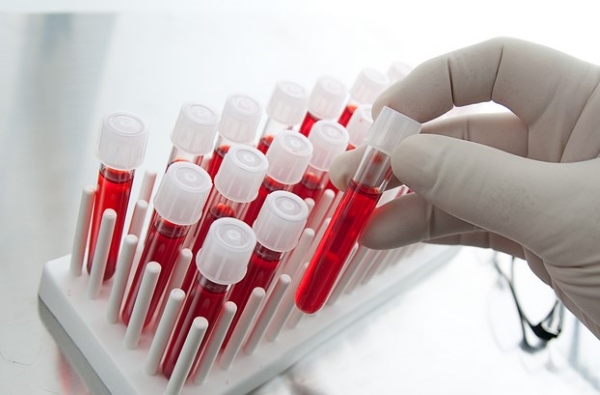
It is in order to fix the level of sugar in the blood, jumps in its increase or decrease, that specialists prescribe a blood test for sugar. Moreover, sometimes this analysis is taken as a preventive measure in order to exclude a disease such as diabetes mellitus.
Blood chemistry
This blood test is often used in general examination, therapy, gastroenterology, rheumatology and other areas. It allows you to determine the state of internal organs and body systems. The analysis is taken from a vein on an empty stomach in the morning.
Here is an example of a card that is filled out after a patient donates blood:
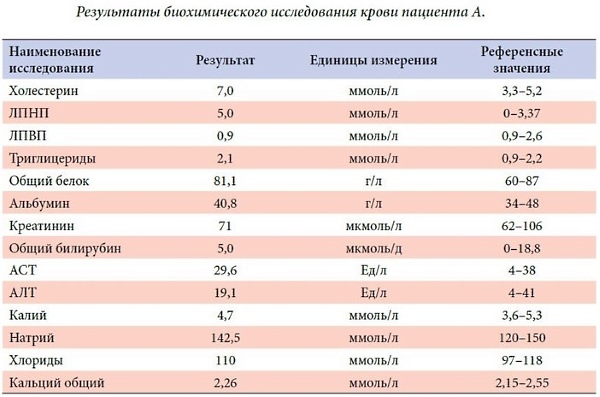
To be able to correctly decrypt the data, you need to know the rules. These are those indicators that do not threaten the state of human health, but if the analysis indicators go beyond the norm, it doesn’t matter, up or down, then this becomes a reason for additional studies that the doctor prescribes.
If you take a biochemical blood test, then the norm indicators will depend on age:
- in children under 2 years old, an indicator from 2.78 to 4.4 mmol / l is considered the norm;
- at the age of 2 to 6, the following range will be the norm - from 3.3 to 5 mmol / l;
- in schoolchildren, the norm includes figures in the range from 3.3 to 5.5 mmol / l;
- the norm of an adult is considered to be a range of t 3.88 to 5.83 mmol / l;
- in old age, figures from 3.3 to 6.6 mmol / l are considered normal.
You can open the curtain of complex medical terms and meanings if you watch a special video in which the doctor deciphers the readings of a blood test and tells what this or that designation in the analysis means and how these indicators can affect health, what they tell about the state of the body.
Blood test for glucose tolerance
The study is carried out on an empty stomach with a load. The load here means the following: the subject comes to the laboratory and donates blood on an empty stomach, after 5 minutes from the moment of blood sampling he is given a glass of water with dissolved glucose to drink. Further, the laboratory assistant takes blood every half an hour for 2 hours. This research method makes it possible to fix the level of glucose in the blood plasma.
If a glucose tolerance test is carried out with a load, then the norm indicators will be common for everyone - for men, for women, and for children. The limits of the norm in the framework of this study are no more than 7.8 mmol. But it should be noted that the exact indicators of the norm depend on the age of the patient:

This study is also prescribed for women who are carrying a child, as there is a threat of gestational diabetes mellitus, which can cause complications during childbirth and harm the health of the child, if measures are not taken and glucose is not controlled.
This test is also called HbA1C. It shows the blood glucose level as a percentage for the last three months. It can be taken at any convenient time. It is considered the most accurate as it helps to determine how the glucose balance has fluctuated recently. Based on these indicators, specialists often make adjustments to the diabetes control program for patients.
As for glycated hemoglobin, here the norm indicator does not depend on the age and gender of the subject, and is equated to an indicator of 5.7%. If, with this test, the final figures show a value of more than 6.5%, then there is a threat of diabetes.
There are also indicators of the target level of glycated hemoglobin, which are determined by the age of the patient. The decoding of indicators is presented in the table:
![]()
If the results of the passed test showed some deviations, this is not a reason to sound the alarm, because such a phenomenon can be caused not by internal pathology, but by external factors, such as stress. It is believed that blood sugar levels may drop in people who are prone to anxiety disorders.
Preparing for a blood sugar test
Despite the fact that special preparation is not required when passing the described study, experts still recommend taking a few tips into service, and minimally preparing for the test so that you do not have to retake it:
- A blood test for sugar should be taken on an empty stomach. But, this does not mean that it is enough just not to eat in the morning. The term “fasting” means that at least 8 hours have passed from the moment of the last meal to the moment of blood sampling for analysis, and preferably all 12 hours. At the same time, it is allowed to drink only water, clean, non-carbonated, and even more so not sweet.
- 2 days before the scheduled analysis, it is recommended to stop eating fatty foods, fried foods and alcoholic beverages. If, nevertheless, there was a feast before the test, then it is better not to waste time and come to take the test 2 days later than it was scheduled.
- A blood test for sugar is taken only in the morning, it is advisable to do this before 9 am, and it is better to come by the time the laboratory opens, that is, at 7 o'clock.
- If the test fluid is taken from a vein, then stressful situations and heavy physical exertion should be avoided the day before. Even specialists, before starting the procedure, give the patient 10-15 minutes of rest to calm down after the trip to the laboratory.
- The test should be taken before taking any medications, especially if they are antibiotics. You must either wait with the start of the course of taking the drugs, or wait until the end of the course of treatment, and only then undergo tests.
- You can not donate blood after an X-ray, rectal examination and physiotherapy procedures.
- Some people can hardly tolerate blood sampling, especially on an empty stomach, therefore, after the test, it is advisable to remain at rest for some time, so as not to faint. In such cases, you need to take ammonia with you.
Tests that allow you to establish the level of glucose in the blood, take place in a laboratory and involve the collection of the test fluid from a patient's vein or finger.
It is very important to undergo these studies not only for diabetics, but also for healthy people, since it is these tests that help to notice the pathology in time and begin timely further examination and treatment. It is recommended as a preventive measure to donate blood for sugar twice a year with an interval of 6 months.


